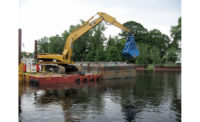The U.S. Environmental Protection Agency has rejected objections raised by General Electric Co. to a final cleanup plan, issued in February, for toxics in the Housatonic River in New England. But if the conglomerate pursues new legal challenges, it remains unclear how and when the $613-million remediation and monitoring program will proceed for the 125-mile stretch of waterway, which was contaminated by PCBs from manufacturing decades ago.
PCBs, or polychlorinated biphenyls, leached into the river from GE’s Pittsfield, Mass., electrical transformer plant that operated from 1930 to 1977. Most of the 20 “hot spot” sites along a two-mile stretch have been cleaned up under a 2000 consent decree. GE now must remove PCB-contaminated sediment from the river, riverbanks and some floodplain soil in an additional 11-mile area to reduce farther movement downstream. The Housatonic runs from western Massachusetts through Connecticut to the Long Island Sound.
The cleanup includes a combination of soil and sediment removal, riverbed capping and natural recovery monitering in selected reaches of the river. Some contaminated soil in the 10-year floodplain will be removed, and some PCB-contaminated riverbanks will be stabilized using bioengineering techniques to restore disturbed banks. All excavated contaminated soil and sediment will be shipped out of state to a licensed disposal facility. The agency is using an “adaptive management” approach that allows for the use of the best available technologies and approaches. Innovative technologies will be used to treat the PCBs if they are proven to be effective. Activated carbon will be used in some areas to reduce the bio-availability of the PCBs.
GE has not yet decided whether, either administratively or in federal court, to challenge EPA’s rejection of its objections and hopes to resolve the decision’s shortcomings, says Susan Bishop, a GE spokeswoman. “GE will clean up the Housatonic ‘rest of river.’ The only question is how it will be cleaned,” she says. GE has argued for on-site disposal, saying EPA’s final decision is “arbitrary, capricious and unlawful” because on-site disposal would not result in an unreasonable risk to human health or the environment. EPA’s decision will become final 30 days after the Oct. 24 decision, unless GE seeks redress. The cleanup will take about two years to complete the initial design and 13 years to implement.
“GE does not provide sufficient information to determine that EPA’s conclusions are incorrect, unreasonable or unsupported,” says Carl Dierker, EPA regional counsel. “Given the scope and variability associated with a site of this size and complexity … the approach is entirely reasonable and supported by data.”
GE spent about $435 million on the first two phases of the Housatonic cleanup. Phase one, completed in 2002, included the first half mile downriver from the transformer plant. The 1.5-mile second phase was completed in late 2006. EPA in 2014 proposed the rest-of-the-river plan, which GE formally protested in 2016. In addition, prior to the consent degree, EPA had directed cleanup at one heavily contaminated portion of the upper reach. As a result, GE excavated and disposed of 7,230 cu yd of heavily contaminated sediment and riverbank soil. Sediment removal was performed “in the dry” by installing sheet pile into the river and diverting flow around the sheet pile, dewatering and removing the sediment with standard excavating equipment.
Meanwhile, EPA next April will issue a final report on the effectiveness of GE’s six-year, $1.5-billion effort to dredge 2.75 million cu yd of PCBs from the upper Hudson River from a defunct factory in Troy, N.Y. Work was completed last year. Media reports say GE removed twice the amount of PCBs that originally was estimated, but officials are just beginning analysis of toxic levels in fish and will start long-term sediment monitoring this fall. Also, some activists want dredging of 136 more acres.




